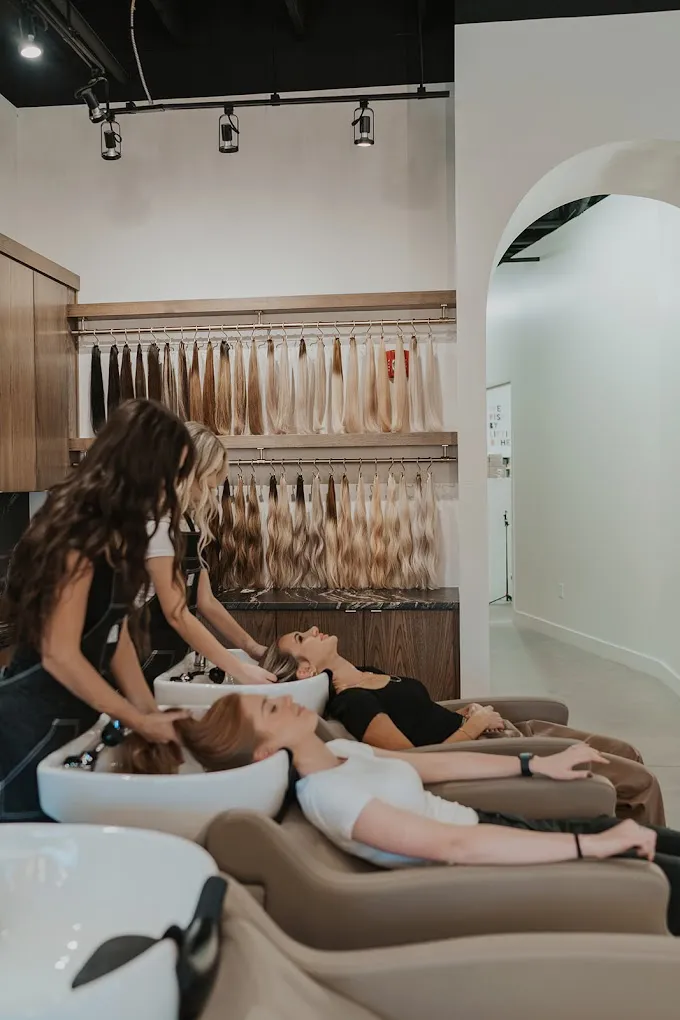How to Keep Micro K-Tips Extensions Pristine and Gorgeous

Micro K-Tips extensions are a premium hair solution designed for seamless blending, strand-by-strand precision, and long-lasting wear. Applied using a heat-activated keratin bond, these extensions require mindful maintenance to stay smooth, secure, and damage-free over time. Unlike other types of extensions, Micro K-Tips are lightweight yet durable, making them ideal for extended wear when cared for properly.
This guide covers essential maintenance routines, including daily habits, product choices, styling techniques, and the importance of professional check-ins. Whether you're a stylist educating a client or an individual seeking to protect your investment, these best practices ensure your Micro K-Tips remain beautiful and bond-safe throughout their wear cycle.
Key Takeaways
- Daily care routines protect extension health and density.
- Proper washing and gentle drying practices keep bonds intact.
- Limiting heat and chemicals preserves adhesive strength.
- Adapted styling reduces mechanical stress and breakage.
- Regular professional care can extend extension longevity.
Daily Care for Micro K-Tips Extensions

Consistent daily care is the cornerstone of maintaining the look, feel, and bond security of your Micro K-Tips extensions. Unlike other extension methods, Micro K-Tips are bonded individually, making them more prone to damage from tangling, rough handling, and tension at the root. A gentle, structured routine helps you protect both the extensions and your natural hair.
Use the Right Tools for Detangling
Start each day by gently detangling your hair with a wide-tooth comb or an extension-safe brush. Begin at the ends and work upward in sections to avoid pulling on the bonds. Avoid brushing when the hair is wet, as it's more elastic and prone to snapping. Tools made with flexible bristles or designed for use with extensions are ideal for minimizing strain on the keratin bonds.
Brush Strategically and Gently
Brushing shouldn’t be aggressive or constant. Once or twice a day is sufficient, focusing on mid-lengths and ends. If you need to smooth the top, use a soft bristle brush without disrupting the bonds. This preserves your extension placement and reduces unnecessary friction.
Avoid Over-Manipulation
Frequent tugging, tying, or adjusting the extensions can create tension at the root, leading to premature bond breakdown or even traction on your natural hair. Avoid overly tight ponytails, buns, or twisting the extensions during the day. When tying your hair back, opt for loose styles secured with silk or satin accessories to reduce bond friction and stress.
Washing and Drying Techniques That Preserve Bonds

How you wash and dry your Micro K-Tips extensions plays a critical role in preserving the adhesive bond and maintaining the overall quality of the hair. Keratin bonds are sensitive to harsh ingredients, aggressive motions, and high heat, all of which can weaken the connection between the extensions and your natural hair. Gentle, moisture-conscious routines can significantly extend the life of your installation.
Choose Sulfate-Free, Alcohol-Free Products
Always opt for shampoos and conditioners free from sulfates, alcohol, and parabens. These ingredients can strip natural oils and compromise the keratin adhesive. Look for moisturizing and pH-balanced formulas to reduce dryness and prevent frizz. Hydrating, protein-enriched products are ideal for maintaining softness without loosening the bonds.
Use a Downward Washing Motion
When cleansing your scalp and hair, use your fingertips (not nails) and apply product downward. Avoid bunching or swirling the hair while washing, leading to tangling and stress on the bonds. Focus on cleansing the scalp and allowing the shampoo to run through the lengths, usually enough to clean the extensions without direct scrubbing.
Dry with Low Heat and Patience
After washing, gently squeeze out excess water and pat the hair dry using a microfiber towel or cotton T-shirt. Avoid rough towel-drying or wringing the hair. If air drying, let the hair fall naturally. If blow drying, use the cool or lowest heat setting while avoiding direct heat on the bonds. High temperatures can soften or weaken the keratin, leading to premature slippage.
K-tips Extensions Bond Preservation Tips

The strength of the keratin bonds is what keeps Micro K-Tips secure and seamlessly blended with your natural hair. While the bonds are durable, they are still vulnerable to heat, oils, and chemical exposure. Preserving bond integrity means adjusting your habits and product choices to avoid weakening the adhesive or loosening the attachment.
Limit Heat and Chemical Exposure
High temperatures can soften the keratin and reduce its ability to hold, especially when applied directly to the bond area. Always use a heat protectant spray before styling with hot tools, and keep the heat source at least an inch away from the roots where the bonds are located. Avoid coloring, bleaching, or chemically treating the extensions, as these processes can disrupt the keratin and damage the structure of the hair.
Avoid Products That Break Down Adhesives
Many conventional hair products contain oils, alcohols, or silicones that can cause bond slippage over time. Be especially cautious with leave-in treatments, root sprays, and serums. Apply styling products to mid-lengths and ends only, steering clear of the bonded area. Stick to lightweight, alcohol-free formulas that won’t interfere with adhesion.
Deep Condition Strategically
While deep conditioning is essential for keeping the hair soft and hydrated, it should never be applied directly at the roots. Focus on the mid-lengths to ends, using a silicone-free, nourishing mask. Rinse thoroughly to prevent residue buildup near the bonds, which can cause slippage or make the extensions feel heavy.
Smart Styling Techniques to Reduce Tension and Breakage

Styling your Micro K-Tips extensions doesn’t mean compromising their durability. In fact, your styling habits directly impact how long the bonds hold and how natural the extensions continue to look. Choosing low-tension hairstyles, using protective tools, and avoiding common mechanical stressors’ll minimize breakage and keep your extensions looking polished.
Opt for Low-Heat, Loose Hairstyles
Whenever possible, go for styles that don’t pull tightly on the scalp or bonds. Loose waves, low ponytails, or gentle half-up styles are great options that allow the hair to move freely without causing unnecessary strain. When heat styling is needed, use tools with adjustable temperature settings and keep them on low. Avoid placing heat directly at the root where the keratin bonds sit.
Use Extension-Friendly Accessories
The right accessories make a big difference in maintaining the health of your extensions. Replace elastic bands and metal clips with silk scrunchies, soft hair ties, or fabric-lined claws that don’t snag or pull. These gentler alternatives reduce friction and tension, especially around the bonds, which helps preserve their structure.
Rotate Your Styles to Avoid Repetitive Stress
Wearing the same style every day can lead to repeated stress in specific areas, weakening the bonds or even causing traction on your natural hair. Rotate between styles—alternate between down, updos, and braids—to give both your hair and the bonds time to relax.
Preventing Common Issues Before They Start

Preventing damage is often easier—and more effective—than trying to reverse it. Micro K-Tips extensions are susceptible to environmental stressors, friction, and moisture-related issues. You can avoid tangling, dryness, and premature bond failure with a few preventive steps, keeping your extensions smooth and secure.
Minimize Exposure to Heat, Sun, and UV Rays
Excessive sun and UV exposure can dry out the hair and weaken keratin bonds over time. If you spend a lot of time outdoors, apply a UV-protectant spray to the lengths of your hair (avoiding the roots) or wear a hat for extra coverage. This helps preserve moisture and keeps the extensions from becoming brittle or frizzy.
Protect Hair During Sleep
Friction from pillowcases and restless movement at night can cause tangling and bond stress. To prevent this, loosely braid your hair or tie it in a low ponytail using a silk scrunchie before bed. Sleeping on a silk or satin pillowcase also reduces friction, helping the hair glide smoothly and stay tangle-free.
Avoid Swimming Without Protection
Chlorine and salt water can strip moisture from the extensions and degrade the keratin bonds. Wear a snug-fitting swim cap if swimming is unavoidable or keep your hair dry and tied up. After exposure, rinse immediately with fresh water and follow with a hydrating conditioner to minimize damage.
The Role of Professional Maintenance

Even with perfect daily care, professional maintenance ensures your Micro K-Tips extensions remain secure, healthy, and aesthetically flawless. Regular visits to a qualified stylist protect your investment and prevent common issues like bond slippage, uneven growth, or unnoticed damage that could compromise the extensions and your natural hair.
Schedule Maintenance Every 6–8 Weeks
Routine salon visits every 6 to 8 weeks allow your stylist to check for bond movement, early signs of slippage, or matting near the roots. This timing aligns with natural hair growth and allows your stylist to reposition or remove any extensions that need adjusting.
Get Bond Replacements and Adjustments
During maintenance appointments, your stylist can replace or reapply keratin bonds that have loosened or shifted. This ensures even weight distribution across your scalp, reducing stress on individual hair strands and preventing long-term damage.
Benefit from Customized Advice and Treatments
A stylist experienced in Micro K-Tips can offer tailored hair care product recommendations based on your hair type, lifestyle, and seasonal needs. They may also apply salon-grade conditioning treatments or scalp care protocols to keep your natural hair healthy underneath the extensions.
Conclusion
Micro K-Tips extensions offer a seamless, long-lasting way to enhance your hair—but they require thoughtful, consistent care to stay in top condition. From gentle daily habits to smart product choices and professional maintenance, each step in your routine plays a role in preserving the integrity of the keratin bonds and the hair's natural beauty.
By following the best practices outlined in this guide, you can avoid damage, extend the lifespan of your extensions, and keep your look polished and healthy from root to tip. With the right care, your Micro K-Tips will remain secure, soft, and stunning for weeks.
Frequently Asked Questions
How often should I wash my Micro K-Tips extensions?
Wash your extensions every 7–10 days using a sulfate-free, alcohol-free shampoo. Focus on scalp cleansing while keeping friction and tangling to a minimum.
Can I use heat styling tools on my extensions?
Yes, but always apply a heat protectant and avoid placing the tool directly on the keratin bonds. Use the lowest effective temperature to style the hair safely.
What kind of brush should I use for detangling?
A wide-tooth comb or an extension-safe paddle brush with flexible bristles works best. Start detangling from the ends and work your way up to avoid tugging at the bonds.
Do I need to see a stylist even if my extensions feel fine?
Yes. Regular check-ins every 6–8 weeks help your stylist identify any hidden bond slippage or scalp tension and allow for professional adjustments to prevent long-term issues.
What ingredients should I avoid in my hair products?
Stay away from sulfates, drying alcohols, silicones, and heavy oils—especially near the root and bond area. These ingredients can weaken the adhesive and cause buildup.